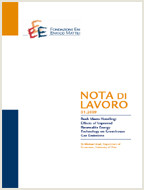Challenges and Opportunities for Integrated Modeling of Climate Engineering

21.06.2017
Q5, Q55
Climate Engineering, Paris Agreement, Carbon Dioxide Removal, Solar Radiation Management, Integrated Assessment Models
Mitigation, Innovation and Transformation Pathways
Massimo Tavoni
The Paris Agreement has set stringent temperature targets to limit global warming to 2°C above preindustrial level, with efforts to stay well below 2°C. At the same time, its bottom-up approach with voluntary national contributions makes the implementation of these ambitious targets particularly challenging. Climate engineering – both through carbon dioxide removal (CDR) and solar radiation management (SRM) – is currently discussed to potentially complement mitigation and adaptation. Results from integrated assessment models already suggest a significant role for some forms of climate engineering in achieving stringent climate objectives1. However, these estimates and their underlying assumptions are uncertain and currently heavily debated2–4. By reviewing the existing literature and reporting the views of experts, we identify research gaps and priorities for improving the integrated assessment of climate engineering. Results point to differentiated roles of CDR and SRM as complementary strategies to the traditional ones, as well as diverse challenges for an adequate representation in integrated assessment models. We identify potential synergies for model development which can help better represent mitigation and adaptation challenges, as well as climate engineering.
***
Suggested citation: Tavoni, M., V. Bosetti, S. Shayegh, L. Drouet, J. Emmerling, S. Fuss, T. Goeschl, C. Guivarch, T. S. Lontzek, V. Manoussi, J. Moreno-Cruz, H. Muri, M. Quaas, W. Rickels, (2017), ‘Challenges and Opportunities for Integrated Modeling of Climate Engineering’, Nota di Lavoro 38.2017, Milan, Italy: Fondazione Eni Enrico Mattei
